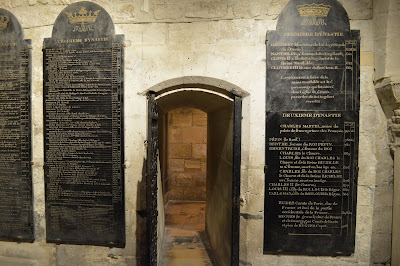 If you are staying near Paris consider visiting the Saint Denis Basilica - a necropolis for the kings of France. It's possibly the largest collection of dead royalty anywhere.
If you are staying near Paris consider visiting the Saint Denis Basilica - a necropolis for the kings of France. It's possibly the largest collection of dead royalty anywhere.This is a large building which has been partially restored over time but there's a lot of work still to be done. It's also frustrating at times because the tombs don't necessarily contain anything, or there might just be a heart or a bit of intestine supposedly there. One must admit, these kings and their queens have not had peace in death. They've been abused, in many cases.
The basilica stands on the site of a Gallo-Roman cemetery with the tomb of Saint Denis who was martyred circa 250AD. It was a place of pilgrimage in the 5th century. It became one of the most powerful Benedictine abbeys in the Middle Ages. Most of the kings and queens of France were buried here from the 6th century onwards.
 Improvements were made as the centuries passed but, here we go again, it plunged into decline by wars and the French Revolution. It was restored in the 19th century by architect Viollet-le-Duc before becoming a cathedral in 1966.
Improvements were made as the centuries passed but, here we go again, it plunged into decline by wars and the French Revolution. It was restored in the 19th century by architect Viollet-le-Duc before becoming a cathedral in 1966.Though it is hard to appreciate now, many of the recumbent statues were coloured. Traces of paint remain on some. Others seem to have had golden crowns but they have disappeared leaving only the holes where they were attached. How splendid they must once have been. Many of the later statues display extremely fine carving of clothes.

Notable areas inside:
Recumbent statues made around 1263, 14 remain from 16.
Recumbent statues of the Valois such as Charles V are a masterpiece of medieval sculpture.

The tomb of Francois I, his wife Claude and three of their children is here.
The Bourbon chapel honours the Bourbon dynasty and contains the desiccated heart of 10 year old Louis XVII who died in the Temple prison during the Revolution. It's in a glass urn and isn't in good shape as the liquid preserving the heart was partially emptied out.
 Stone sarcophagi from before 590AD are mostly empty, having been plundered in the past for clothes and jewellery and just plain spitefulness.
Stone sarcophagi from before 590AD are mostly empty, having been plundered in the past for clothes and jewellery and just plain spitefulness.The Bourbon grave that contains the remains of Louis XVI and Marie-Antoinette (transferred from the Madeleine cemetery). Louis XVIII was the last king to be buried here in 1842.
 The royal ossary contains bones exhumed from the royal tombs at the time of the revolution and gathered together by Louis XVIII. Desecration of royal tombs meant the remains ended up in ditches and common pits. Who knows who is what but apparently part of Philippe d'Orleans, Louis XIV's brother, is there behind a plaque in the wall.
The royal ossary contains bones exhumed from the royal tombs at the time of the revolution and gathered together by Louis XVIII. Desecration of royal tombs meant the remains ended up in ditches and common pits. Who knows who is what but apparently part of Philippe d'Orleans, Louis XIV's brother, is there behind a plaque in the wall.Louis XII and Anne de Bretagne are represented dead, naked and flayed inside the Carrara marble tomb. Charming, not.
There are statues of the Merovingian kings and queens and the older King Dagobert
 Two metal tombs contain the two children of Saint Louis who died in infancy.
Two metal tombs contain the two children of Saint Louis who died in infancy.The praying statues of Louis XVI and Marie Antoinette were commissioned by their descendant Louis XVIII in 1830.
Quite a number of the stained glass windows were destroyed during the Revolution and had to be replaced in the 19th century.
 The glass windows on some sides remain damaged. There's still a lot of renovation work needed here.
The glass windows on some sides remain damaged. There's still a lot of renovation work needed here.On the day we visited some 'nutter' dressed oddly like a monk was pacing around the nave shouting. I couldn't understand a word he was saying and visitors around me were feeling uncomfortable as he seemed to be unpredictable and aggressive. We gave him a wide berth.
Sometimes there are guided tours but the day we visited they decided not to have any and gave preference to large tour groups which was annoying when queuing for entry. They had two cashiers on duty but the second one needed reminding that individuals were wanting to get in. JC muttered about 'fonctionnaires' and I had to agree. It's still worth a visit, especially on a hot day. If you arrive on a cold day bring warm clothes.















1 comments:
Interesting, thanks for posting Frances.
Post a Comment
I welcome your comments, contributions and feedback.